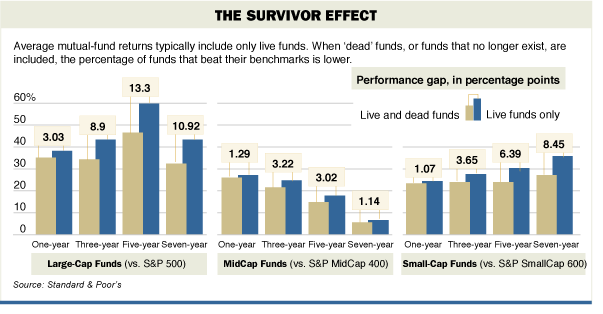Survivorship bias
Post on: 2 Июль, 2015 No Comment

<(Stock indexing| state=collapsed>> In finance, survivorship bias. also known as survivor bias, refers to the tendency for mutual funds or hedge funds that have produced poor performance or low asset accumulations to be either liquidated or merged out of existence. In the case of long term global asset returns, survivorship bias comes into play with the extinction of whole markets due to war and or revolution. The result is an overestimation of past returns, as these poor returning funds/national markets are dropped from the data base. [1]
Contents
Mutual fund survivorship bias
A Gruber, Elton, Blake study [2] of survivorship bias in U.S. mutual funds examines the period between 1976-1993. The paper has a section devoted to a review of prior studies (along with their methodology problems). Here are the numbers:
Brown & Goetzmann [3]  : examining raw returns fund data from 1976-1988 found overestimation bias of 20 and 80 basis points, depending on the weighing scheme. Malkiel (1994) [4] using unadjusted raw data found overestimation bias of 150 basis points.
Gruber, Elton, Blake: Modelers attempting to determine bias measure performance either by considering the common stock investing policy at the beginning of the period or by considering the common stock investing policy throughout the period. The study authors report both approaches. The authors prefer a risk-adjusted three index method (passive benchmarks for large cap stocks, small cap stocks, bonds and bills) over all other measuring methods, such as single index (S&P 500 index), or raw returns. The following table, reproduced from the paper, shows survivorship bias results according to various methodologies for the 1976-1993 period. Panel A looks at results assuming investment ends at the point the fund disappears from the data record via merger or policy change. Panel B shows a follow the money method, assuming the the investment continues to be held in the new merged fund after the disappearing fund has been merged. GE&B also mention their 1993 paper [5] on survivorship bias in bond funds. Using similar risk-adjusted three index factor methodology the authors report 27 basis points of overestimated return due to survivorship bias.
Additional findings from Grubar, Elton, Blake:
- Disappearing funds are mostly small funds.
- The funds into which the disappearing funds are merged tend to have higher expense ratios. The expense ratio tends not to decline after the merger.
- The funds into which the disappearing funds are merged tend to have better past performance records. Performance tends to drop after the merger.
Table 1. Alternate Measures of Survivorship Bias (1976-1993) from Grubar, Elton, and Blake
Panel A. Through month of merger or policy change
Common stock at beginning














